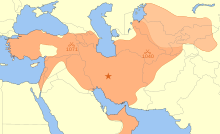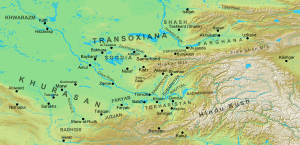Berkyaruq
| |||||
|---|---|---|---|---|---|
| Sultan Shahanshah | |||||
 Investiture scene of Berkyaruq, from the 14th-century bookJami' al-tawarikh | |||||
| Sultanof theSeljuk Empire | |||||
| Reign | 1094–1105 | ||||
| Predecessor | Mahmud I | ||||
| Successor | Malik-Shah II | ||||
| Born | 1079/80 Isfahan | ||||
| Died | 1105 (aged 25) Borujerd | ||||
| Issue | Malik-Shah II Zubayda Khatun | ||||
| |||||
| House | House of Seljuk | ||||
| Father | Malik-Shah I | ||||
| Mother | Zubayda Khatun | ||||
| Religion | Sunni Islam | ||||
Rukn al-Din Abu'l-Muzaffar Berkyaruq ibn Malikshah(Persian:ابو المظفر رکن الدین برکیارق بن ملکشاه,romanized:Rukn al-Dīn Abuʿl-Moẓaffar Berkyāruq ibn Malik-Šāh;1079/80 – 1105), better known asBerkyaruq(برکیارق), was the fifthsultan[a]of theSeljuk Empirefrom 1094 to 1105.
The son and successor ofMalik-Shah I(r. 1072–1092), he reigned during the opening stages of the decline and fragmentation of the empire, which marked the rise ofTurkomanatabegatesand principalities, which would eventually stretch fromKirmantoAnatoliaandSyria.His reign was marked by internal strife, mainly against other Seljuk princes. By his death in 1105, his authority had largely vanished. His infant sonMalik-Shah IIbriefly succeeded him, until he was killed by Berkyaruq's half-brother and rivalMuhammad I Tapar(r. 1105–1118).
Name
[edit]Berkyaruqis aTurkicword meaning "firm, unwavering light".[2]Contrary to theirGhaznavidpredecessors—who had largely abandoned their Turkic heritage in favour of Persian—the Seljuks maintained and took pride in their origins, carrying Turkic names such as Berkyaruq, Arslan Arghu or Sanjar.[3]
Background
[edit]Born in 1079 or 1080[4]in the Seljuk capital ofIsfahan,[5]Berkyaruq was the oldest son ofMalik-Shah I(r. 1072–1092) and the latter's cousin, the Seljuk princessZubayda Khatun.[6][7][8]Berkyaruq was only thirteen at the time of his father's death in November 1092, meaning that there were no princes of age to inherit the vast Seljuk empire.[9][10]Berkyaruq's half-brotherMuhammad Taparwas eleven, while another half-brother namedMahmudwas four. A brother of Malik-Shah titledTutush I,who ruledSyriaon his brother's behalf, claimed the throne as the only adult, but gained little support from the Turkic elite.[11]Malik-Shah's death thus marks the start of the decline and fragmentation of the empire, withamirsand palace elites trying each to gain power by supporting one of his young sons as sultan.[11][9]This would ultimately mark the start ofTurkomanatabegatesand principalities, which would later stretch fromKirmantoAnatoliaand Syria.[9]
One of Malik-Shah's wives,Terken Khatun,in cooperation with the Seljuk vizierTaj al-Mulk,installed her four-year-old son Mahmud on the throne at Baghdad.[12]She convinced theAbbasidcaliphal-Mustazhir(r. 1094–1118) to have thekhutba(friday sermon) read in Mahmud's name, and sent an army under the amirQiwam al-Dawla Kirbuqato take Isfahan and capture Berkyaruq.[11]Meanwhile, the family and supporters of the deceased Seljuk vizierNizam al-Mulk(known as the "Nizamiyya" ), led by the Turkic slave-soldier (ghulam) Er-Ghush, supported Berkyaruq. They had Berkyaruq smuggled out of Isfahan and sent to his atabeg (guardian) Gumushtigin inSavehandAveh,who had him crowned atRay.[13][12]
Reign
[edit]Initial challenges and consolidation of power
[edit]
Although Berkyaruq was generally supported by the Nizamiyya, the modern historianClifford Edmund Bosworthstates that "this does not necessarily imply that the Nizamiyya had a collective policy, for none of the sons of Nizam al-Mulk was his father's equal in ability, and opportunism and personal factors seem often to have swayed them".[14]The Nizamiyya were most importantly looking to seek vengeance against Taj al-Mulk, who was believed to have been behind the death of his rival Nizam al-Mulk (which according to modern historianAndrew Peacock,was probably partly true).[11][14][15]A battle took place between the two factions in January 1093, resulting in the defeat of Mahmud's supporters and the capture of Taj al-Mulk. Berkyaruq, aware of Taj al-Mulk's bureaucratic prowess, was willing to make him his vizier.[15]Taj al-Mulk had even managed to appease a section of the Nizamiyya through bribery. Still, this was not enough: the Nizamiyya, thirsty for revenge, secured his execution on 12 February.[15][16]Terken Khatun soon summoned the Seljuk prince Ismail ibn Yaquti to attack Berkyaruq. Although the former had raised an army of Turkoman fromAzerbaijanandArran,he was defeated and executed by Berkyaruq's atabeg Gumush-Tegin.[16]Terken Khatun then tried to reach out to Tutush, but suddenly died in 1094, with her sickly son Mahmud dying a month later.[11][16]

Berkyaruq also had to deal with his uncle Tutush, who invaded theJaziraand western Iran, seizing the city of Ray. He was, however, killed by Berkyaruq's forces near the same city on 25 February 1095.[11][8]Berkyaruq thus managed to consolidate his authority in western Iran and Iraq, and was also acknowledged as the sultan by al-Mustazhir.[11][9]During the chaos that ensued, Malik-Shah's brother Arghun Arslan conquered most ofKhurasan(except the city ofNishapur), attempting to establish his own principality in the province. Berkyaruq first sent an army under his uncle Bori-Bars ibn Alp-Arslan in 1095 to conquer Khurasan, but the latter was captured and killed. He sent a second army under his half-brotherAhmad Sanjarin 1097, but before anything occurred Arghun Arslan was killed by one of his ownghulams,due to his brutal treatment of his subjects. Berkyaruq appointed Sanjar as the vassal ruler (malik) of Khurasan, giving him his own atabeg (Amir Qumaj) and vizier (al-Tughrai).[17][18][19]
Berkyaruq then led an expedition as far east asTirmidh,where he confirmed theQarakhanidsSulayman-tegin and Mahmud-tegin as the vassal rulers ofTransoxiana.[20]He also appointedQutb al-Din Muhammadas the new governor of theCentral Asianregion ofKhwarazm,thus marking the start of theKhwarazmian dynasty.[21][22]He spent seven months in the city ofBalkh,and then returned to the west.[23]However, after leaving his eastern possessions, the area was plunged into a series of revolts, including one by the Seljuk prince Dawlatshah. The name of Berkyaruq started to get excluded from the coins struck at Nishapur, which testifies to the slow disintegration of his rule in Khurasan. Preoccupied by continuous internal issues, Berkyaruq was unavailable to respond to the advent of theFirst Crusadein Syria in 1097. The crusadersbesieged Antiochand sackedMa'arrat al-Nu'man.Furthermore, Berkyaruq had little reason to help the Seljuks of Syria, who fought amongst themselves, dividing the country. The northern part was ruled byFakhr al-Mulk Radwan,and the southern part byShams al-Muluk Duqaq.When the Crusaders entered Syria, Ridwan shifted his allegiance from Berkyaruq to theFatimid Caliphate.[20]
Conflict with Muhammad I Tapar
[edit]
The most difficult challenge that Berkyaruq faced was the rebellion of his half-brother Muhammad in 1098 or 1099. The rebellion had been encouraged by Nizam al-Mulk's sonMu'ayyid al-Mulk,who had formerly served Berkyaruq and played a key-role in the defeat of Tutush. After his dismissal by Berkyaruq, he entered into the service of Muhammad, who appointed him as his vizier. Mu'ayyid al-Mulk made use of his newfound position to exact vengeance on his rivals, which was made easier because Muhammad had yet to reach adulthood (approximately 17 years old at the time). The Nizamiyya and the prominent families of Isfahan also joined Muhammad, stopping Berkyaruq from entering the city.[24]The rebellion was launched from Muhammad's base at the city ofGanjain Arran, which had been given to him as aniqta'(land grant) by Berkyaruq back in 1093.[25]
Muhammad's capture of Ray exposed the vulnerability of Berkyaruq's realm. Sa'd al-Dawla Gawhara'in, theshihna(military administrator) of Baghdad, soon joined Muhammad, which implies that the city was also added to his domain. Nevertheless, the five-year war continued to be indecisive, with Baghdad repeatedly changing hands. Even with the support of Sanjar (who despised Berkyaruq), Muhammad was unable to defeat his rival. Berkyaruq's authority continued to weaken, and by 1104, with his treasury exhausted, he was forced to sue for peace.[26]A treaty was subsequently made, which acknowledged Muhammad as the ruler of southern Iraq, northern Iran, theDiyar Bakr,Mosuland Syria, while Berkyaruq was acknowledged as the ruler of the rest of Iran (including Isfahan) and Baghdad. The treaty, however, did most likely not display the true circumstances of the situation. The following year (1105), there were no coin mints citing the name of Berkyaruq in the central Islamic lands.[27]En route to Isfahan, he died oftuberculosisat the age of 25 near the town ofBorujerd,and was succeeded by his infant sonMalik-Shah II.[28]Baghdad was subsequently captured by Muhammad, who had Malik-Shah II killed.[27]
Notes
[edit]- ^In addition tosultan,the ancient Persian title ofKing of Kings(shahanshah) was also used by the Seljuks.[1]
References
[edit]- ^Tor 2012,p. 150 (see also note 24).
- ^Bosworth 2001,p. 305.
- ^Tetley 2008,p. 27.
- ^Bosworth 1968,pp. 220–221.
- ^Özaydın 1992,p. 514.
- ^Van Donzel 1994,p. 464.
- ^Bosworth 1968,p. 77.
- ^abTetley 2008,p. 128.
- ^abcdBosworth 1988,pp. 800–801.
- ^Cahen 1960,p. 1051.
- ^abcdefgPeacock 2015,p. 76.
- ^abBosworth 1968,p. 103.
- ^Tetley 2008,p. 105.
- ^abBosworth 1968,p. 104.
- ^abcBosworth 1997,pp. 12–13.
- ^abcBosworth 1968,p. 105.
- ^Peacock 2015,pp. 76–77.
- ^Bosworth 1968,pp. 105–106.
- ^Tetley 2008,p. 131.
- ^abPeacock 2015,p. 77.
- ^Bosworth 1986,p. 140.
- ^Bosworth 1978,p. 1067.
- ^Richards 2014,p. 291.
- ^Peacock 2015,p. 78.
- ^Tetley 2008,p. 148.
- ^Peacock 2015,pp. 78–79.
- ^abPeacock 2015,pp. 80, 133.
- ^Özaydın 1992,p. 516.
Sources
[edit]- Blake, Stephen P. (2002).Shahjahanabad: The Sovereign City in Mughal India 1639–1739.Cambridge University Press.ISBN978-0-521-52299-1.
- Bosworth, C. E.(1968). "The Political and Dynastic History of the Iranian World (A.D. 1000–1217)". In Frye, R. N. (ed.).The Cambridge History of Iran, Volume 5: The Saljuq and Mongol periods.Cambridge: Cambridge University Press. pp. 1–202.ISBN978-0-521-06936-6.Archived fromthe originalon 2022-01-23.Retrieved2021-03-16.
- Bosworth, Clifford Edmund (1978)."K̲h̲wārazm-S̲h̲āhs".Invan Donzel, E.;Lewis, B.;Pellat, Ch.&Bosworth, C. E.(eds.).The Encyclopaedia of Islam, Second Edition.Volume IV: Iran–Kha.Leiden: E. J. Brill.OCLC758278456.
- Bosworth, C. E.(1986)."Anūštigin Ḡaṛčaʾī".Encyclopaedia Iranica, Vol. II, Fasc. 2.p. 140.
- Bosworth, C. E.(1988)."Barkīāroq".InYarshater, Ehsan(ed.).Encyclopædia Iranica, Volume III/8: Bardesanes–Bayhaqī, Ẓahīr-al-Dīn.London and New York: Routledge & Kegan Paul. pp. 800–801.ISBN978-0-71009-120-8.
- Bosworth, C. E.(1997)."Ebn Dārost, Tāj al-Molk Abu'l-Ḡanā'em Marzbān".InYarshater, Ehsan(ed.).Encyclopædia Iranica, Volume VIII/1: Ebn ʿAyyāš–Economy V.London and New York: Routledge & Kegan Paul. pp. 12–13.ISBN978-1-56859-050-9.
- Bosworth, C.E.(2001). "Notes on Some Turkish Names in Abu 'l-Faḍl Bayhaqī's Tārīkh-i Masʿūdī".Oriens.36.Brill: 299–313.doi:10.2307/1580488.JSTOR1580488.
- Cahen, Cl (1960)."Barkyārūḳ".InGibb, H. A. R.;Kramers, J. H.;Lévi-Provençal, E.;Schacht, J.;Lewis, B.&Pellat, Ch.(eds.).The Encyclopaedia of Islam, Second Edition.Volume I: A–B.Leiden: E. J. Brill. p. 1051-1053.OCLC495469456.
- Özaydın, Abdülkerim (1992)."Berkyaruk".TDV Encyclopedia of Islam, Vol. 5 (Balaban – Beşi̇r Ağa)(in Turkish). Istanbul:Turkiye Diyanet Foundation,Centre for Islamic Studies.ISBN978-975-389-432-6.
- Peacock, A. C. S.(2015).The Great Seljuk Empire.Edinburgh University Press. pp. 1–378.ISBN978-0-7486-3826-0.
- Richards, D.S. (2014).The Annals of the Saljuq Turks: Selections from al-Kamil fi'l-Ta'rikh of Ibn al-Athir.Routledge.ISBN978-1-317-83254-6.
- Tetley, Gillies (2008).The Ghaznavid and Seljuk Turks: Poetry as a Source for Iranian History.Routledge.ISBN978-1-134-08438-8.
- Tor, Deborah (2012). "The Long Shadow of Pre-Islamic Iranian Rulership: Antagonism or Assimilation?". In Bernheimer, Teresa; Silverstein, Adam J. (eds.).Late Antiquity: Eastern Perspectives.Oxford: Oxbow. pp. 145–163.ISBN978-0-906094-53-2.
- Van Donzel, Emeri Johannes(1994).Islamic Desk Reference.Leiden: E. J. Brill.ISBN978-90-04-09738-4.
Further reading
[edit]- Lewis, Bernard(2003).The Assassins: A Radical Sect in Islam(3 ed.).Basic Books.ISBN978-0-465-00498-0.
- Madelung, Wilferd;Daftary, Farhad;Meri, Josef W.(2003).Culture and Memory in Medieval Islam: Essays in Honor of Wilferd Madelung.I.B. Tauris.ISBN978-1-86064-859-5.
